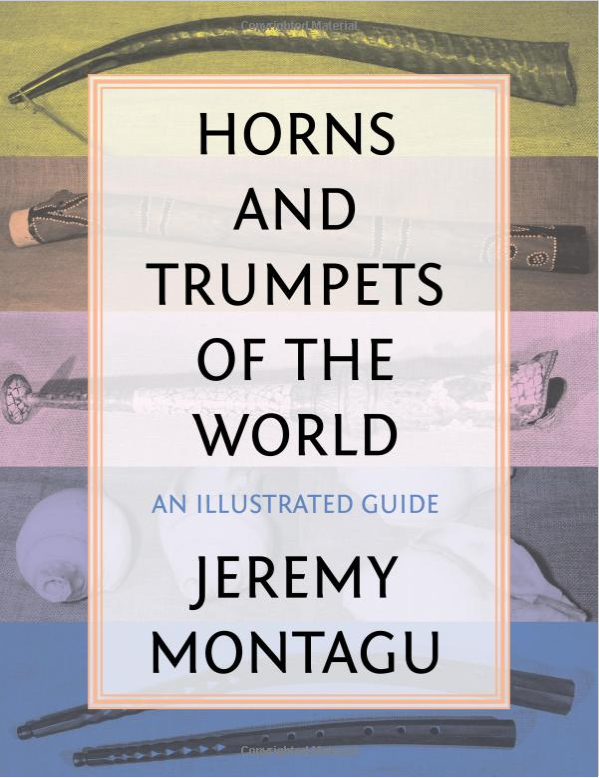Jeremy Montagu
 Horns and Trumpets of the World: An Illustrated Guide:
Horns and Trumpets of the World: An Illustrated Guide:
Lanham, MD, United States
Publisher: Rowman & Littlefield Publishers
Date of Publication: 2014
URL: http://www.rowman.com
Language: English
book. 256 pages.
Primary Genre: Study Material - book
 Horns and Trumpets of the World: An Illustrated Guide:
Horns and Trumpets of the World: An Illustrated Guide: Lanham, MD, United States
Publisher: Rowman & Littlefield Publishers
Date of Publication: 2014
URL: http://www.rowman.com
Language: English
book. 256 pages.
Primary Genre: Study Material - book
Despite its somewhat limited title, this book includes a fair amount of useful information about the trombone. Written by Jeremy Montagu, retired curator of Oxford’s Bate Collection of Historical Instruments, it features trombone in two separate chapters: “‘Orchestral’ Trumpets and Slide Trombone,” and “Valved Horns, Trumpets, and Trombones.” Roughly 30 pages of material treat the trombone directly, in addition to the chapters that address brass in a more general way, such as those on the “technology” of brass instruments and on playing brass instruments. Also included in the book is an unusually thorough treatment of non-Western brass instruments (or lip-reed instruments). Because the book’s emphasis is on organology, the author’s area of expertise, there is extensive information on physical details and measurements of instruments. The book is an “illustrated guide” in the sense that there are numerous black and white photographs of instruments, primarily from the author’s own personal collection. The author’s tone is fairly informal, at times reading more like a personal memoir than a scholarly volume. This is by no means a criticism, only an observation. Some of the historical insights in the book are valuable for even the casual trombone performer. For example, Montagu discusses the historically common narrow-bore “pea shooter” trombones from England and the subsequent historical change in bore size: “The pea-shooter remained the standard English trombone up to the late 1940s, and it was only starting in the 1950s that taste there generally came to prefer the wider-bore American model…There is no doubt that the wider bore produces a fuller sound than the pea-shooter, but the narrower bore has a ‘ping’ and sharpness of attack that is much missed in some French and English music today” (117). Montagu specifically cites composers such as Elgar, Holst, Offenbach, and Berlioz in connection with the use of small-bore trombones. If these insights do not change the actual instrumentation we employ in such works, they may at least inform our interpretation. Also of interest is the author’s thorough historical treatment of the brass valve, including its application to the trombone. Montagu specifically discusses and pictures several types of valve trombones. Some of the author’s broad historical statements are open to question. Montagu states, for example, “Even the earliest medieval illustrations that we have of sackbuts look to be of the tenor size” (116). But this is demonstrably false. Two of the three earliest depictions of the medieval trombone, sackbut if you prefer, actually show instruments that are proportionately much closer to the alto trombone in size than the tenor. Using a detail of the art works, if you compare the length of the trombones in Benedetto da Maiano’s Coronation of Alfonso II (1494-97) and Gentile Bellini’s Procession (1496) to the height of the people playing the trombone, you can get a reasonable feel for the proportion and relative size of the trombones they hold. In both cases, the full length of the trombone is clear and unobscured, as is the full height of the standing player. In both examples, 2 ½ lengths of the trombone will fit within the height of the player. We know the general length of a tenor trombone in B-flat or A from the back bow of tubing to the end of the slide. As it turns out, proportionately, if those are tenor trombones, then the players holding them are approximately 9 feet tall! (If we stipulate that the slides may not be completely closed in the depictions, then the trombones must be even shorter than supposed or the players even taller.) By this proportional measurement, at least, the instruments are closer to alto trombone in size. Other readers might quibble not so much with Montagu’s specific demarcations of the differences between sackbut and trombone as with the relative practicality and usefulness of such distinctions; many modern scholars have abandoned the distinction between the terms and now refer to the instrument simply as trombone from its beginnings in the 15th century up to the present. Indeed, the Italian term trombone has been used continuously from the instrument’s inception to the present time. Be that as it may, this volume’s exhaustive detail, with page after page of extant examples, four separate indices, including an index of makers, as well as the author’s unique relationship with the instruments discussed, make it a valuable addition to the brass player’s library. -Will Kimball Brigham Young University
Reviewer: Review Author
Review Published July 9, 2023
Review Published July 9, 2023